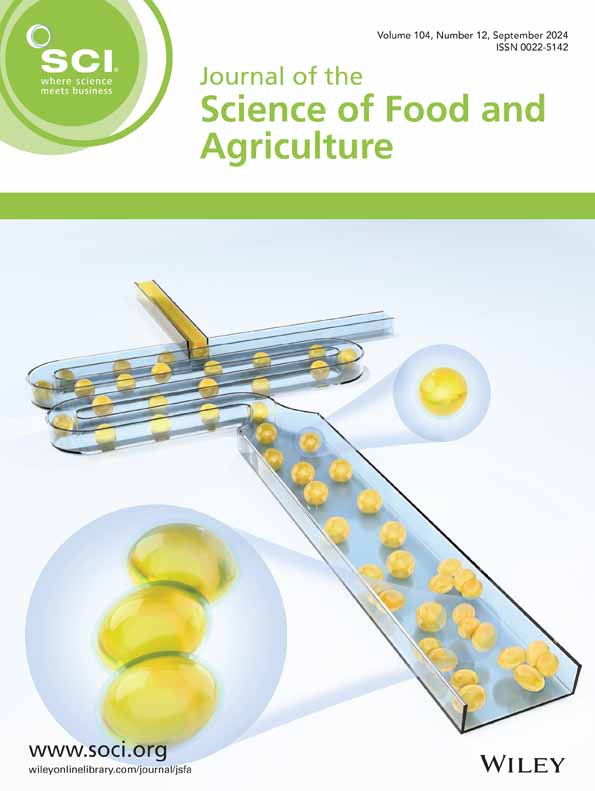Juliana Silva de Oliveira, Hilario Cuquetto Mantovani, Arlan Araujo Rodrigues, Igor Machado Ferreira, Edson Mauro Santos
求助PDF
{"title":"牧草仙人掌与反刍动物病原微生物的生长。","authors":"Juliana Silva de Oliveira, Hilario Cuquetto Mantovani, Arlan Araujo Rodrigues, Igor Machado Ferreira, Edson Mauro Santos","doi":"10.1002/jsfa.14266","DOIUrl":null,"url":null,"abstract":"<p><p>Forage cactus is a major food grown in arid and semiarid regions, and serves as a nutraceutical for humans and a nutrient source for ruminants. However, high inclusion in ruminant diets may cause nutritional disorders like diarrhea. This review examines the chemical traits, sugars and microbiota of forage cactus and their link to pathogenic microbes in ruminants. Recent studies have linked diarrhea in animals to contamination of forage cactus with pathogenic microorganisms. This is attributed to the chemical characteristics of the plant, such as high moisture content and neutral detergent-soluble carbohydrates (NDSCs). These characteristics make forage cactus a suitable substrate for the development of Escherichia coli and other pathogens in animal feed. Additionally, its high passage rate can favor the growth of pathogenic and opportunistic microorganisms in the small and large intestines of ruminants, causing diarrhea. To mitigate these nutritional disorders, especially under smallholder management, the inclusion of cactus in the diet must be balanced. Practices such as using larger particle sizes, including a food source with lower NDSCs and higher fiber content, and ensiling can reduce the incidence of nutritional disorders in animals fed diets containing forage cactus. Complementary measures, such as improved hygiene and reducing the exposure time of crushed cactus to air, are crucial to further minimize risks. These practices enable the safe inclusion of higher proportions of forage cactus in ruminant diets, ensuring animal health and productivity. © 2025 Society of Chemical Industry.</p>","PeriodicalId":17725,"journal":{"name":"Journal of the Science of Food and Agriculture","volume":" ","pages":""},"PeriodicalIF":3.3000,"publicationDate":"2025-04-22","publicationTypes":"Journal Article","fieldsOfStudy":null,"isOpenAccess":false,"openAccessPdf":"","citationCount":"0","resultStr":"{\"title\":\"Forage cactus and the growth of pathogenic microorganisms in ruminants.\",\"authors\":\"Juliana Silva de Oliveira, Hilario Cuquetto Mantovani, Arlan Araujo Rodrigues, Igor Machado Ferreira, Edson Mauro Santos\",\"doi\":\"10.1002/jsfa.14266\",\"DOIUrl\":null,\"url\":null,\"abstract\":\"<p><p>Forage cactus is a major food grown in arid and semiarid regions, and serves as a nutraceutical for humans and a nutrient source for ruminants. However, high inclusion in ruminant diets may cause nutritional disorders like diarrhea. This review examines the chemical traits, sugars and microbiota of forage cactus and their link to pathogenic microbes in ruminants. Recent studies have linked diarrhea in animals to contamination of forage cactus with pathogenic microorganisms. This is attributed to the chemical characteristics of the plant, such as high moisture content and neutral detergent-soluble carbohydrates (NDSCs). These characteristics make forage cactus a suitable substrate for the development of Escherichia coli and other pathogens in animal feed. Additionally, its high passage rate can favor the growth of pathogenic and opportunistic microorganisms in the small and large intestines of ruminants, causing diarrhea. To mitigate these nutritional disorders, especially under smallholder management, the inclusion of cactus in the diet must be balanced. Practices such as using larger particle sizes, including a food source with lower NDSCs and higher fiber content, and ensiling can reduce the incidence of nutritional disorders in animals fed diets containing forage cactus. Complementary measures, such as improved hygiene and reducing the exposure time of crushed cactus to air, are crucial to further minimize risks. These practices enable the safe inclusion of higher proportions of forage cactus in ruminant diets, ensuring animal health and productivity. © 2025 Society of Chemical Industry.</p>\",\"PeriodicalId\":17725,\"journal\":{\"name\":\"Journal of the Science of Food and Agriculture\",\"volume\":\" \",\"pages\":\"\"},\"PeriodicalIF\":3.3000,\"publicationDate\":\"2025-04-22\",\"publicationTypes\":\"Journal Article\",\"fieldsOfStudy\":null,\"isOpenAccess\":false,\"openAccessPdf\":\"\",\"citationCount\":\"0\",\"resultStr\":null,\"platform\":\"Semanticscholar\",\"paperid\":null,\"PeriodicalName\":\"Journal of the Science of Food and Agriculture\",\"FirstCategoryId\":\"97\",\"ListUrlMain\":\"https://doi.org/10.1002/jsfa.14266\",\"RegionNum\":2,\"RegionCategory\":\"农林科学\",\"ArticlePicture\":[],\"TitleCN\":null,\"AbstractTextCN\":null,\"PMCID\":null,\"EPubDate\":\"\",\"PubModel\":\"\",\"JCR\":\"Q1\",\"JCRName\":\"AGRICULTURE, MULTIDISCIPLINARY\",\"Score\":null,\"Total\":0}","platform":"Semanticscholar","paperid":null,"PeriodicalName":"Journal of the Science of Food and Agriculture","FirstCategoryId":"97","ListUrlMain":"https://doi.org/10.1002/jsfa.14266","RegionNum":2,"RegionCategory":"农林科学","ArticlePicture":[],"TitleCN":null,"AbstractTextCN":null,"PMCID":null,"EPubDate":"","PubModel":"","JCR":"Q1","JCRName":"AGRICULTURE, MULTIDISCIPLINARY","Score":null,"Total":0}
引用次数: 0
引用
批量引用

 求助内容:
求助内容: 应助结果提醒方式:
应助结果提醒方式:


